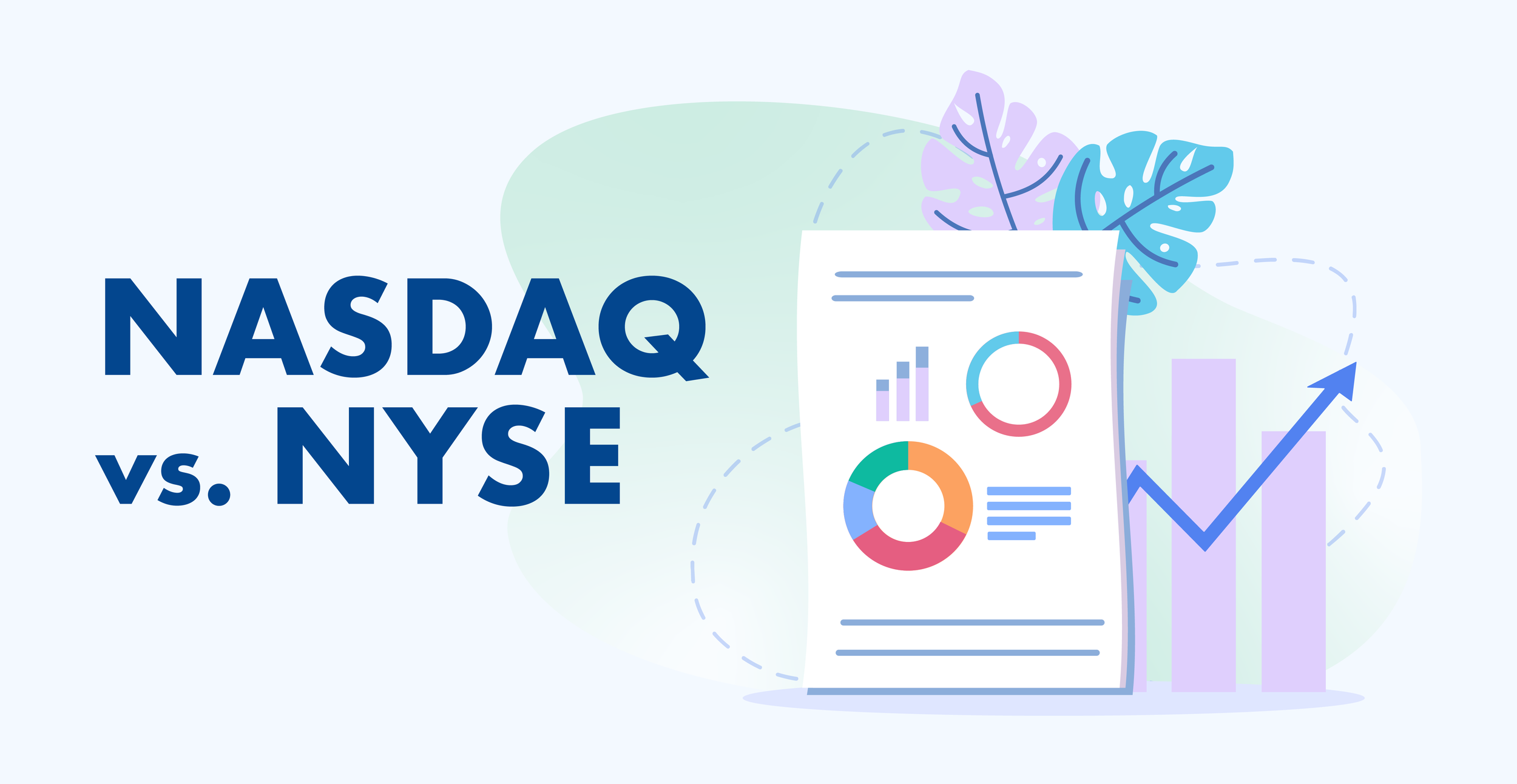NASDAQ vs NYSE: What's the Difference?
What is the NASDAQ vs. NYSE? Discover their historical backgrounds, trading mechanisms, listed companies, trading volume, market capitalization, and public perception.
When investors think of the stock market, two major players often come to mind: NASDAQ (National Association of Securities Dealers Automated Quotations) and NYSE (New York Stock Exchange). These leading American stock exchanges play significant roles in the global financial market. Recognizing what is the NASDAQ vs. NYSE difference can help investors gain insights into how businesses operate within these markets and make more informed decisions when trading stocks, shaping their investment strategies accordingly.
Historical Background
The NYSE's roots trace back to 1792 when 24 stockbrokers signed the Buttonwood Agreement under a buttonwood tree, birthing this iconic institution. Today, it houses trades for around 2,800 companies, ranging from blue-chip to high-growth entities, with a daily trading volume of about 1.46 billion shares.
In contrast, NASDAQ, founded in 1971, made history as the world's first electronic stock market. With over 3,300 listed companies, it distinguishes itself with its technological savviness and facilitates around 1.8 billion trades daily.
Nature of the Markets
Trading on the NYSE: The Role of Specialists and Brokers
Trading on the New York Stock Exchange operates in an auction format, which involves a dynamic interaction of buyers and sellers. This mechanism is orchestrated by two critical players on the NYSE floor: specialists and brokers.
Brokers represent the interests of an investment firm or its clients. They bring the buy and sell orders from investors to the floor of the NYSE. These orders are then handed over to specialists, who manage specific stocks.
Specialists have a unique role. Stationed in one location on the floor, they manage one or several specific stocks, depending on the volume of trades. Their task is to accept buy and sell orders from brokers and facilitate the actual auction. They ensure there's always a market for their specified stocks, even investing their firm's capital if necessary to maintain the market's activity and the shares' liquidity.
The Dealer Market System of NASDAQ
On the other side, the NASDAQ functions differently as it operates as a dealer market. This market structure is characterized by its automated electronic nature, eliminating the need for a physical trading floor.
In the NASDAQ's dealer market, transactions are carried out through market makers. These market makers are responsible for maintaining a specific inventory of a particular stock. They stand ready to buy or sell these stocks at publicly quoted prices, ensuring a degree of liquidity in the market.
Unlike the NYSE, where brokers interact with specialists, brokers on the NASDAQ buy and sell stocks directly through these market makers. This system allows for trades to be executed in a swift and seamless manner, reflecting the high-tech reputation of the NASDAQ.
On the other hand, NASDAQ functions as a dealers' market. It employs an electronic system where brokers interact with market makers rather than each other. These market makers hold a certain number of stocks, enabling swift, direct transactions with brokers. For those interested in ETF trading, NASDAQ offers some of the more popular ETFs in the tech sector.
Trading Volume and Market Capitalization
The question of what is the NASDAQ vs. NYSE difference extends to trading volume and market capitalization. Despite NASDAQ facilitating more daily trades, NYSE surpasses it in market capitalization, attesting to the economic size of the NYSE-listed companies.
Type of Listed Companies
NYSE has a reputation for housing strong, high-quality securities, including blue-chip companies. Its stringent listing requirements help uphold this status.
NASDAQ is often associated with high-tech, high-growth, and volatile stocks, with many newer businesses choosing it for listing. Some of the world's biggest companies also call NASDAQ home.
Trading Systems
Another point of distinction lies in the trading systems. NYSE uses a hybrid model, employing both human interaction and technology. It still maintains a physical trading floor, but most exchanges take place electronically at its data center in New Jersey.
Conversely, NASDAQ, an entirely electronic exchange, needs no physical floor. Trading happens through automated computer networks, underscoring its reputation as a high-tech exchange.
Public Perception and Listing Costs
When considering what is the NASDAQ vs. NYSE difference in terms of public perception, NYSE is generally seen as the safer bet due to its established, blue-chip companies. NASDAQ, with its high-growth tech stocks, tends to be seen as more volatile.
Listing costs also differ significantly. It is often 70% to 80% cheaper for a company to list its stock on NASDAQ than on the NYSE, making it an attractive option for newer, smaller businesses.
Ownership Structure
Historically, the NYSE operated as a privately traded corporation for nearly 214 years until it went public in 2006. The NASDAQ, on the other hand, was a publicly traded corporation from the start. Today, both exchanges operate as publicly traded corporations, with shares available for purchase on their respective exchanges. They both comply with the Securities and Exchange Commission's standard filing requirements.
What is the NASDAQ vs. NYSE?
In essence, the NYSE and NASDAQ, while similar in their core purpose, differ in their operation, listed companies, and trading mechanisms. Understanding the distinctions - what is the NASDAQ vs. NYSE difference - is key for investors in choosing suitable stocks and creating effective investment strategies.
Whether you lean towards the blue-chip stability of the NYSE or the high-tech growth potential on the NASDAQ, understanding these differences is an integral part of your investment journey. But having the right trading platform can make the difference between a good and a great investing experience. Firstrade offers a comprehensive suite of investment products, including Stocks/ETFs, Options, and over 11,000 Mutual Funds, all with $0 commission on trades and $0 contract fees on options. Investors can also explore various Fixed Income products on the platform.

